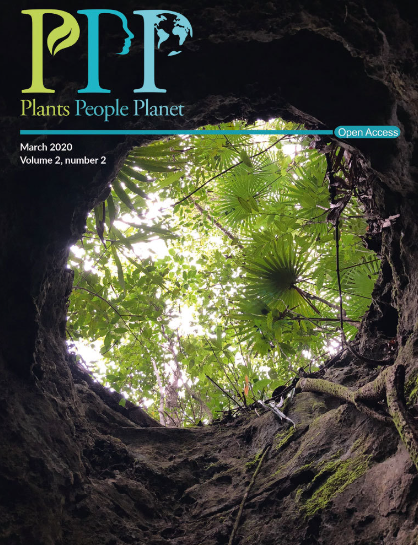Essential plant nutrients impair post‐germination development of Striga in sorghum
IF 3.6
2区 环境科学与生态学
Q1 BIODIVERSITY CONSERVATION
引用次数: 0
Abstract
Infestation by the parasitic weed Striga is a major cause of cereal crop production losses on smallholder farms in Africa. Essential plant nutrients play an important indirect role in parasite seed germination, the first prerequisite for successful parasitism. Here, we demonstrate that increasing the nutrient availability for the host plant can also impede Striga development beyond its germination, independent of the resistance levels of the sorghum host. This insight provides additional support for crop protection recommendations to Striga‐affected farmers. Growing a resistant crop variety combined with adequate levels of fertilisers should be the backbone of defence against this parasitic weed. Striga hermonthica is a widespread parasitic weed in sub‐Saharan Africa and an important biotic constraint to sorghum production. Resistant varieties and fertilisers are crucial components of integrated Striga management. N and P fertilisers reduce the production of host‐plant strigolactones, known as Striga germination stimulants, and thereby reduce infection. Whether essential plant nutrients affect the parasite–host interaction beyond Striga germination is unknown. We conducted mini‐rhizotron assays to investigate the effects of macronutrient and micronutrient availability on post‐germination Striga development. Four sorghum genotypes (Framida, IS10978, N13, IS9830) covering the complete array of known mechanisms of post‐attachment resistance were compared with susceptible genotype Ochuti. Plants were infected with pre‐germinated Striga seeds and subjected to four nutrient treatment levels: (1) 25% of the optimal concentration of Long Ashton solution for cereals; (2) 25% macronutrient and optimal micronutrient concentration; (3) optimal macronutrient and 25% micronutrient concentration; and (4) optimal macronutrient and micronutrient concentrations. Compared with the 25% base nutrient level, treatments supplemented with macronutrients reduced the number of viable vascular connections established by pre‐germinated Striga seedlings as well as the total parasite biomass on the sorghum root system. Macronutrient treatment effects were observed across sorghum genotypes, independent of the presence and type of post‐attachment resistance, but appeared to specifically improve mechanical resistance, hypersensitive and incompatibility responses before Striga reaches the host‐root xylem. This study demonstrates, for the first time, that nutrient availability drives Striga parasitism beyond the germination stages. Increased availability of nutrients, in particular macronutrients, enhances host‐plant resistance in post‐attachment stages, reinforcing the importance of current fertiliser recommendations.必需的植物营养物质损害高粱Striga发芽后的发育
寄生杂草斯特里加的侵扰是非洲小农户谷物作物产量损失的主要原因。必需的植物养分在寄生虫种子萌发中起着重要的间接作用,这是成功寄生的第一个先决条件。在这里,我们证明了增加寄主植物的养分有效性也可以阻止Striga在发芽后的发育,而与高粱寄主的抗性水平无关。这一见解为向受斯特里加影响的农民提出作物保护建议提供了额外的支持。种植具有抗性的作物品种,加上适当水平的肥料,应该是防御这种寄生杂草的支柱。稻月Striga是一种广泛分布于撒哈拉以南非洲的寄生杂草,是高粱生产的重要生物制约因素。抗性品种和肥料是Striga综合管理的关键组成部分。氮肥和磷肥可以减少寄主植物独角兽内酯的产生,从而减少感染。独角兽内酯被称为促萌发剂。是否必需的植物营养物质影响寄生-寄主的相互作用超出了寄生菌的萌发是未知的。我们进行了微型根控试验,研究了宏量营养素和微量营养素有效性对褐藻萌发后发育的影响。4种高粱基因型(Framida, IS10978, N13, IS9830)覆盖了已知的附着后抗性机制的完整序列,并与易感基因型Ochuti进行了比较。用预先发芽的Striga种子侵染植株,并对其进行四种营养水平处理:(1)谷物用Long Ashton溶液最佳浓度的25%;(2) 25%宏量营养素和最佳微量营养素浓度;(3)最佳常量营养素和25%的微量营养素浓度;(4)常量营养素和微量营养素的最佳浓度。与25%的基础营养水平相比,添加大量营养元素的处理减少了预先发芽的曲线虫幼苗建立的活维管连接数量以及高粱根系上的寄生虫总生物量。在不同的高粱基因型中观察到大量营养物质的处理效果,与附着后抗性的存在和类型无关,但似乎在Striga到达寄主根木质部之前特异性地改善了机械抗性、超敏性和不亲和性反应。这项研究首次证明,营养供应推动了寄生在发芽阶段之后的寄生。增加营养物质,特别是大量营养物质的供应,可以增强寄主-植物在附着后阶段的抗性,从而加强了当前肥料推荐的重要性。
本文章由计算机程序翻译,如有差异,请以英文原文为准。
求助全文
约1分钟内获得全文
求助全文
来源期刊

Plants People Planet
Multiple-
CiteScore
9.90
自引率
5.90%
发文量
81
审稿时长
12 weeks
期刊介绍:
Plants, People, Planet aims to publish outstanding research across the plant sciences, placing it firmly within the context of its wider relevance to people, society and the planet. We encourage scientists to consider carefully the potential impact of their research on people’s daily lives, on society, and on the world in which we live. We welcome submissions from all areas of plant sciences, from ecosystem studies to molecular genetics, and particularly encourage interdisciplinary studies, for instance within the social and medical sciences and chemistry and engineering.
 求助内容:
求助内容: 应助结果提醒方式:
应助结果提醒方式:


